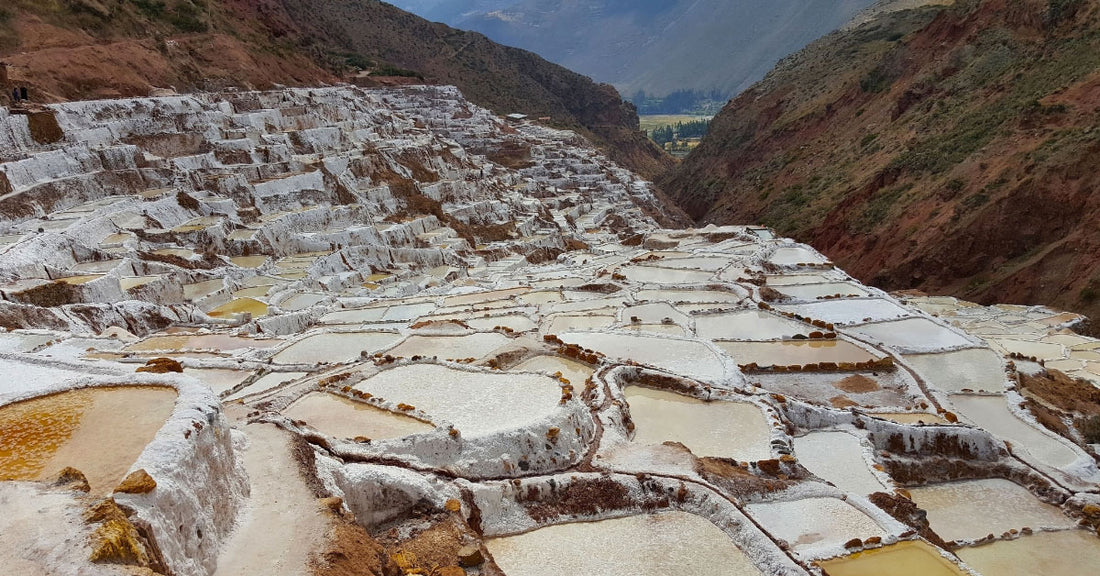We often think that for optimal health, it's best to keep salt intake to a minimum. But did you know that a lack of salt can also be harmful to the body? Discover in this article the benefits of natural salts that promote good health. This is particularly true of a river salt that is unique in the world... the pink salt of Maras.
Finding the balance between too much and too little salt
Salt is generally frowned upon. Many perceive it as a health enemy, leading to a cascade of cardiovascular diseases, notably hypertension.
But salt is often wrongly accused. Instead, it's pure table salt, sodium chloride (NaCl), which is to blame for the association of health problems. This inexpensive salt, available in just about every store, supplies us with a single mineral: sodium. And it's true that over-consumption of sodium can have destructive effects on cardiovascular health. As currently stipulated by the World Health Organization (WHO), consumption of less than two grams of salt a day - one teaspoon - would be a preventive measure against cardiovascular disorders. 1
The fact remains, however, that salt itself is not the food to blame. It's the sodium that's to blame.
That's what Andrew Mente, Professor of Clinical Epidemiology at McMaster University and Principal Investigator at the Population Health Research Institute (PHRI), has done. As Principal Investigator of the PHRI, Andrew Mente investigated the problem of sodium overconsumption by leading a cohort of 130,000 individuals located in 49 countries. The results of this investigation showed that :
- Sodium consumption in excess of 6 grams per day is problematic for cardiovascular health;
- Sodium consumption of less than 3 grams a day is associated with an increase in cardiovascular disorders and mortality;
- Low sodium intake leads to hormonal imbalances;
- The average Canadian consumes between 3.5 and 5 grams of sodium per day, contrary to current recommendations of less than 2.3 grams per day;
- Current recommendations for sodium consumption are set too low;2
In the light of these findings, the scientific community is readjusting its position on salt consumption.
How to choose a quality salt that promotes good health?
While excess sodium can be detrimental to health and lead to imbalances in trace elements, it is clear that the importance of salt in the diet is not negligible.
Ideally, the salt we consume should be unrefined and unprocessed, while offering a variety of minerals, including potassium. This is particularly true of pink salt from Marasa unique salt harvested by hand in the Peruvian Andes.
Unlike more industrialized salts pink salt from Maras is a true example of a pure, natural salt containing a range of minerals including sodium, potassium, magnesium, iron, copper and zinc. With a sodium content as low as 22%, the salt profile of Maras pink salt is balanced and nourishing.
Maras pink salt - unique in the world
Offered by the company Inka Naturethe Maras salt is neither sea salt nor earth salt, but river salt. Unique in the world Maras salt - named after the town of Maras where it originates - is the result of the flow of an underground salt river gushing out at an altitude of over 3,500 metres in the Andes. This ancient sea feeds the region's steep, rice paddy-like salt flats. Only a few families from the local tribes have the privilege of working in these salt pans, passing on the knowledge of harvesting from generation to generation.
For the locals, this is a truly sacred place, a vestige of the Inca and even pre-Inca era. Indeed, legend has it that the river flows through an underground rose quartz mine before emerging. This salt is said to be vibratory.
In addition to its historical significance, the pink salt of Maras has many health benefits, thanks to its low sodium and high potassium content. Unprocessed and hand-harvested, this salt is fairly traded and has no impact on the environment.
Like a conventional salt pink salt from Maras can be used everywhere. It's best added at the end of cooking, or placed on the table for everyone to salt as they please. Its crystals dissolve quickly and the taste of the salt penetrates food to add unrivalled culinary value.
Stored in a cool, dry place Maras pink salt will have less tendency to agglomerate and maintain its freshness for longer.
For a simple recipe featuring Maras pink salttry this Maras pink salt marinated tomato salad.
Salty good health
About the author
Naturopaths of La Boite à Grains
Team of licensed and certified naturopaths (ND) in Gatineau, Outaouais.
Original article written by Véronique Cousineau, Naturopath
Sources :
- Reducing salt intake. World Health Organization. June 2016.
- Low Salt Diets Not Beneficial: Global Study Finds. McMaster University. May 2016.
- Maras salt from Peru. Spice Island.
- Pink salt from Maras. Inka Nature.


